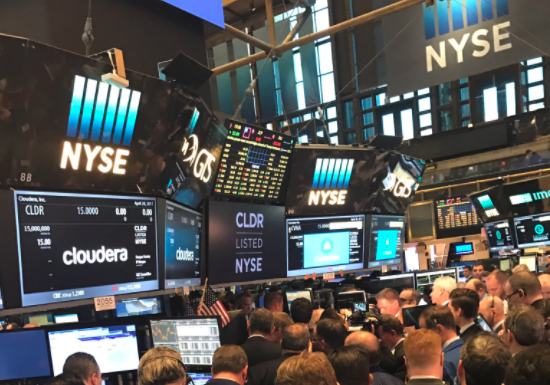 BIG DATA
BIG DATA
 BIG DATA
BIG DATA
 BIG DATA
BIG DATA
Big data pioneer Cloudera Inc. saw its stock pop about 20 percent today as it sold shares to the public for the first time.
The nine-year-old company, which sells software for analyzing and storage huge amounts of data, saw shares rise on the New York Stock Exchange from an initial offering price of $15 to as much as $18.76 a share before dropping back a bit to $18 a share. That’s a mild but still significant vote of confidence.
The offering continues a recent string of successful enterprise and cloud computing software IPOs, such as MuleSoft Inc. and Okta Inc. Indeed, Snap Inc.’s blockbuster IPO aside, enterprise-oriented companies have fared better than consumer IPOs so far this year. Used-car retailer Carvana Co. also went public this morning, but its shares dropped as much as 17 percent from their $15 initial offering price.
The pop didn’t return Cloudera’s valuation to anywhere near the $4.1 billion it commanded when Intel Corp. invested $740 million into the company at $30.95 per share back in June 2014. But the $15 opening price was up from an initial estimate of $12 to $14, raising $225 million for the company.
The valuation “haircut” highlights the difficulty of companies selling open-source software, versions of which are available free, not only to find willing public investors but to make money at all. Only Red Hat Inc. has managed both feats to date. Hortonworks Inc., which went public in December 2014, is still losing plenty of money.
So is Cloudera. The Palo Alto, California-based company posted $261 million in revenue for the fiscal year that ended in January, up 57 percent from a year ago. But it also reported a $187 million loss for the same period, though slightly smaller than the $203 million it had lost the year before.
In an interview today with SiliconANGLE, Mike Olson, Cloudera’s co-founder and chief strategy officer, didn’t directly address the profitability issue but said Cloudera should be viewed more as a traditional software company because it has proprietary components it adds to the open-source software.
“We’re not an open source company,” he said. ‘We’re an enterprise company.”
Olson also emphasized the relationship with Intel, including the ability to take special advantage of features coming in processing and storage from the chip maker. “That allows us to be the innovator,” he said.
Still, Cloudera is cautious in its guidance, stating that shares in the company could be considered a high risk given its history of losses, its long and unpredictable sales cycles, its reliance on revenue from a single software platform and rampant competition.
“The market for data management, machine learning and analytics platforms is intensely competitive and characterized by rapid changes in technology, customer requirements, industry standards and frequent new product introductions and improvements,” Cloudera noted in its S-1 document. “We anticipate continued challenges from current competitors, which in many cases are more established and enjoy greater resources than us, as well as by new entrants into the industry.”
Indeed, some observers harbor doubts about how quickly Cloudera can turn around its losses. George Gilbert, big data analyst with Wikibon, owned by the same company as SiliconANGLE, said the company is trying to extend beyond Hadoop to become a platform both for some general-purpose applications, using the storage manager Kudu, and for machine learning, both areas with broader appeal and growth potential. “But they’re premature on both,” Gilbert said.
Moreover, he said, it’s debatable how much of that opportunity Cloudera can capture. Google Inc., Microsoft Corp. and others may be able to provide those services with much less complexity through their public clouds.
While clearly the headline for Cloudera’s IPO is the fact that it’s a “down round,” in the parlance of lower-valuation venture capital rounds, there is a school of thought that not too much attention should be paid to the previous round. After all, the Intel investment had a large strategic component to it, so it wasn’t driven mostly by financial considerations.
SiliconANGLE noted back in 2014 that the investment in Cloudera was “about much more than just equity.” It was announced as part of a broad strategic technology and business collaboration between the two companies meant in part to maintain the dominant place of the chip maker’s Xeon server processor family in data centers. Just a few weeks before the Intel investment, in fact, T. Rowe Price, Google Ventures, and Michael Dell’s family investment office had invested at a $1.8 billion valuation.
In any case, the IPO represents a victory for Cloudera Chief Executive Tom Reilly, who had been expected by some to be grooming the company for a sale after he joined in June 2013. In an interview with SiliconANGLE last June, he insisted the company was headed for an IPO eventually.
Coming into the float, Cloudera had raised $1.08 billion over eight rounds from investors that included Accel Partners, EquityZen, Greylock Partners, GV, Ignition Partners, Meritech Capital Partners, MSD Capital, SharesPost Investment Management, SV Angel, T. Rowe Price and Intel Capital. It trades under the ticker symbol CLDR.
With reporting from Robert Hof
Support our mission to keep content open and free by engaging with theCUBE community. Join theCUBE’s Alumni Trust Network, where technology leaders connect, share intelligence and create opportunities.
Founded by tech visionaries John Furrier and Dave Vellante, SiliconANGLE Media has built a dynamic ecosystem of industry-leading digital media brands that reach 15+ million elite tech professionals. Our new proprietary theCUBE AI Video Cloud is breaking ground in audience interaction, leveraging theCUBEai.com neural network to help technology companies make data-driven decisions and stay at the forefront of industry conversations.